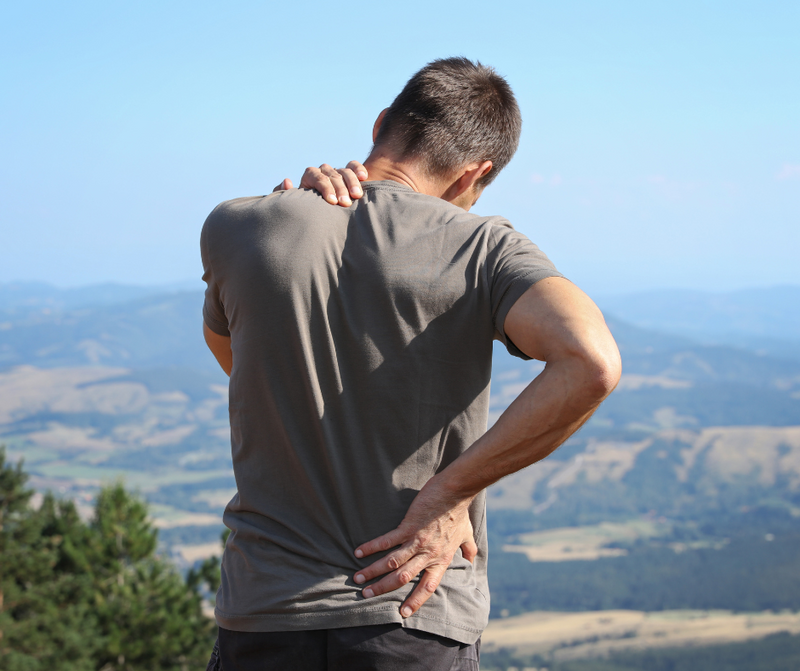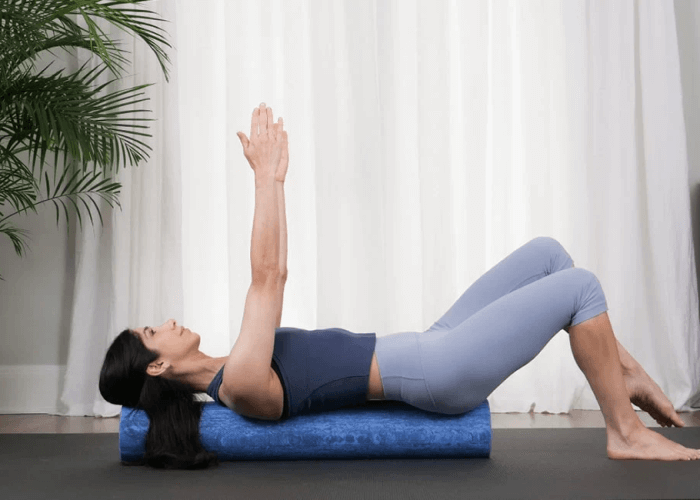5 At-Home Pilates Exercises For Back Pain

Living with lower back pain is more than a minor inconvenience.
We were made to move freely. Movement increases oxygen to your brain, improves mood, and increases creativity. But chronic lower back pain makes even getting out of bed a challenge.
The good news is, that there are tried-and-true Pilates exercises for lower back pain that will get you back in action. Best part? It doesn't involve a gym at all.
Is Pilates Good for Back Pain?
One reason Pilates is good for back pain is that it focuses on core strengthening.
While traditional crunches and situps could potentially exacerbate back pain―Pilates exercises strengthen the muscles in the body that support your back and improves posture. This prevents lower back pain in the future and relieves the twinges of pain right now.
Try these five at-home Pilates exercises to relieve lower back pain.
Pilates Exercise #1: Pelvic Clock
Lower back pain is often accompanied by stiffness. This pre-Pilates exercise is perfect to loosen up the back muscles and fascia while simultaneously gently engaging the abdominal, pelvic floor, and low back muscles.
While this isn’t an “official” Pilates exercise, I often use it as a warm-up in my classes. Many of my clients use this simple and effective exercise in bed before beginning their day. Here’s how it’s done:
- Lay on your back with knees bent and feet hip-width apart. It’s helpful to imagine a clock face on your mat to get into position.
- Envision that noon is under the apex of your low back (straight down through your belly button). Your tailbone should rest at 6 o’clock.
- Begin by alternating between 12 and 6. Lower back down creating gentle flexion of your spine into a low back extension as you press your tailbone into 6 on your mat.
- As you become more comfortable with the movement, you can add in a breath routine. Exhale to rock back into 12 and inhale as you reach your tailbone into 6.
- Next, try pressing into 3 and 9. This one can feel a bit more challenging. Don’t try to force the movement. Just practicing the stretch fires up the core muscles that promote healthy mobility in your spinal joints.
- Last, circle slowly all the way around your clock. Do several circles in one direction and then reverse. As you circle, you might notice one or two “sticky” spots where it feels difficult to get to that number on your clock. Just move slowly and see if you’re able to loosen it up.
Pilates Exercise #2: Toe Taps
Next up is another pre-Pilates exercise that develops the core strength essential for spine stability. While the Pelvic Clock exercise focused on mobility, Toe Taps focus on keeping our spines exactly where they are as we add in leg movement.
- Lying on your back with knees bent and feet hip-width apart, bring one leg up to a 90/90 position. Keep your lower back in a neutral position as you bring the other leg up to meet the first. Some call this a “chair” position because it looks as if you are sitting in a chair except while lying on your back.
- Moving from your hip joint and keeping your knee at 90 degrees, lower one foot towards the floor on your exhale and return it on the inhale.
- Notice where your low back is. Don’t allow it to arch as you begin moving your legs. It doesn’t matter how far down your leg moves. It only matters that you move only as far as you have core control. You can perform 4-6 repetitions on one side or alternate legs.
Pilates Exercise #3: The 100s
Now that you have warmed up your core muscles, you’re ready to do the quintessential Pilates move: The 100s!
In the full expression of the movement, your legs are straight hovering just off the floor. Your head stays up as you pump your arms up and down by your sides. As you might imagine, this move demands ample core strength and control.
To get the most out of this exercise it’s important to pay attention to your body. You’ll have to feel where your back is on the floor, maintaining a connection to the alignment and comfort of your spine.
If you’re new to Pilates, have any spine conditions, have been sedentary, have neck issues, or have past abdominal surgeries, you’ll want to use one of the modifications and progress at your own pace.
For example, if you have osteoporosis or neck issues, you may do this with your head down on the floor. It is much more challenging this way so be sure to adjust your leg height accordingly!
- Beginning on your back with legs in tabletop position, lower your chin towards your chest. Imagine you’re holding an egg between your chin and your sternum. Raise your head up off the floor. At the same time, hover your straight arms above the floor.
- Here is where you’ll need to determine whether tabletop position is right for you. If your back feels strained, try putting your feet back on the floor with both knees bent. If you feel comfortable doing so, straighten both legs while keeping your back from arching up off the floor with the weight of your legs.
- While making small, vigorous pumps with your arms, breathe in for five counts and exhale for five counts. Repeat up to ten breath cycles while maintaining your alignment; if there is any strain, take your legs higher or simply lay back down.
Pilates Exercise #4: Side Lying Legs
Those who suffer with low back pain commonly have weak hip muscles.
Having strong hip muscles is imperative for spinal stability in everyday movements like walking. Side Lying Legs is a great pilates exercise for lower back pain not only because it strengthens the hips, but because it also strengthens your core. Read more about How To Get Strong Hips.
As the name implies, this exercise is traditionally done lying on your side with the legs slightly forward of the body. But, I prefer a contemporary approach that keeps the legs directly in line with the torso since this adaptation of the exercise more closely mimics our standing alignment.
- Lay on your side with the bottom arm straight and under the head. If you have shoulder problems, use a foam roller or cushion for support and put your top arm in front of you with your palm facing up.
- Stack your legs on top of one another. The secret to this pose is to stack your hips so that your bottom waistline feels a small lift rather than sinking down to the floor. Place your fingertips on the floor in front of you to help you maintain your balance.
- With control, kick your front leg forward with a flexed foot and then take it back with a pointed foot. Hinge from your hip only, not your spine. Your elongated spine should never flex or extend. Perform 6-10 repetitions.
- Then stack your top leg on the other, and make small controlled circles with your foot. Imagine drawing circles with the tips of your toes on the opposite wall. When working with clients with low back issues, I keep this exercise slow and focused. If you begin with back circles first, you'll wake up your glute muscles right away. Perform 6 to 8 circles each way.
Pilates Exercise #5: Modified Swan
Modified Swan, a Pilates exercise that stretches the back and strengthens the spine, is an effective way to address two common causes of low back pain: a stiff thoracic spine and weak spinal extensor muscles.
- Lie on your belly with your forehead resting on your hands. Keep your legs slightly lengthened along the mat, and make sure your tailbone is reaching slightly down toward your feet. The goal is to avoid too much extension in the low back so we can target the muscles of the mid to upper back.
- Lift the crown of your head forward and upward, until your forehead rises off your hands. Focus on using the muscles of your mid and upper back to carry the weight of your head. Lower down slowly, then repeat 4-6 times.
- Then, move your arms to a goal post position and repeat a slow lifting and lowering of the head and upper back. You can add in lifting and lowering of your lower arms while keeping the elbows on the ground.
Try Pilates Exercises For Lower Back Pain Relief At-Home
Reading about how to perform these Pilates exercises for lower back pain is one thing. Feeling it in action is a whole new experience for affecting change.
The Sandvi Studio On-Demand Pilates Library has hundreds of guided exercises available at a click of a button. Here are two specific classes in the on-demand library that you can try today with a 7-day free membership trial here.
Each is a great place to begin and then progress to other classes.
PM63, All Levels, 28-Minute Low Back Care
This on-demand Pilates class will strengthen the muscle groups that help relieve lower back pain and balance the pelvis by moving in small but powerful ways.
PM64, All Levels, 41-Minute Low Back Care
This on-demand Pilates class is designed to help people with chronic low back pain. It will mobilize areas that are typically restricted in individuals with low back issues. The moves will also lengthen your tight muscles and strengthen your weak ones. If you feel better after this class, I suggest that you continue taking it twice a week, regularly to move freely well into the future.
Try these classes — and more — in our on-demand library by signing up for the 7-day free membership trial here.
Let's Stay In Touch!




